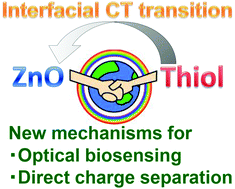Interfacial charge-transfer transitions in ZnO induced exclusively by adsorption of aromatic thiols
Abstract
Interfacial charge-transfer transitions (ICTTs) between organic compounds and inorganic semiconductors have recently gained increasing interest as a new visible light absorption mechanism for optical biosensing via direct visualization, surface enhanced Raman scattering (SERS), and circular dichroism (CD) and also as a direct charge separation mechanism for photoenergy conversions such as photocatalytic reactions. So far, ICTTs have been observed with various organic compounds, while inorganic materials are almost limited to titanium oxides such as TiO2. Although SERS via ICTTs has been reported with several kinds of inorganic semiconductors, their ICTT bands have not been observed directly except for TiO2. From these viewpoints, the direct observation of ICTT bands in inorganic semiconductors other than TiO2 is an important issue. In this study, we demonstrate ICTTs in ZnO induced by the adsorption of aromatic thiols. ICTTs take place from the HOMO of the adsorbed thiol compounds to the conduction band of ZnO via a Ti–S linkage. Notably, ZnO selectively shows ICTTs with aromatic thiols, but almost no ICTT with oxygen-linkage-type organic compounds such as phenol. In addition, the wide-range control of ICTTs was achieved by the chemical modification of aromatic thiols. Our research not only opens up a new way for the research of ICTTs but also supports the reported ICTT-based SERS in ZnO.



 Please wait while we load your content...
Please wait while we load your content...